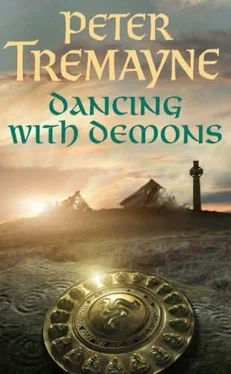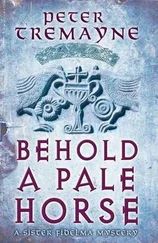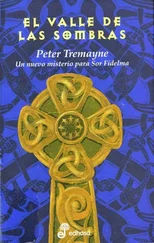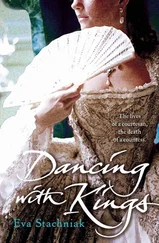Peter Tremayne - Dancing With Demons
Здесь есть возможность читать онлайн «Peter Tremayne - Dancing With Demons» весь текст электронной книги совершенно бесплатно (целиком полную версию без сокращений). В некоторых случаях можно слушать аудио, скачать через торрент в формате fb2 и присутствует краткое содержание. Жанр: Исторический детектив, на английском языке. Описание произведения, (предисловие) а так же отзывы посетителей доступны на портале библиотеки ЛибКат.
- Название:Dancing With Demons
- Автор:
- Жанр:
- Год:неизвестен
- ISBN:нет данных
- Рейтинг книги:4 / 5. Голосов: 1
-
Избранное:Добавить в избранное
- Отзывы:
-
Ваша оценка:
- 80
- 1
- 2
- 3
- 4
- 5
Dancing With Demons: краткое содержание, описание и аннотация
Предлагаем к чтению аннотацию, описание, краткое содержание или предисловие (зависит от того, что написал сам автор книги «Dancing With Demons»). Если вы не нашли необходимую информацию о книге — напишите в комментариях, мы постараемся отыскать её.
Dancing With Demons — читать онлайн бесплатно полную книгу (весь текст) целиком
Ниже представлен текст книги, разбитый по страницам. Система сохранения места последней прочитанной страницы, позволяет с удобством читать онлайн бесплатно книгу «Dancing With Demons», без необходимости каждый раз заново искать на чём Вы остановились. Поставьте закладку, и сможете в любой момент перейти на страницу, на которой закончили чтение.
Интервал:
Закладка:
‘Much hangs in the balance of this investigation, Fidelma,’ Colgú called after her. ‘Perhaps the peace of the five kingdoms itself …’
CHAPTER THREE
Fidelma was correct in that her party, consisting of four riders, reached the gates of the palace of the High King at Tara in the afternoon of the fifth day after leaving Cashel. The five kingdoms of Éireann were well provided with roads. There were six different types of road and each of them classified by a different name. They ranged from a small track called lámrota to the great highways called slíge. There were only five slíge. These were the main arteries of the five kingdoms, which all converged at Tara. The highway that ran from the kingdom of Muman to Tara was called the Slíge Dalla or the Way of the Blind. It carried its unusual name because it was said that it was such a good and well-kept highway that a blind person would have no problem traversing it. It spanned rivers with bridges of wood and stone called droichet and crossed marshes and bogs on causeways called tóchar. A slíge was constructed so that two large wagons had plenty of space to pass one another without having to slow down.
The laws on the repair and maintenance of the roads were strictly enforced. It was the responsibility of the local chieftain, in whose territory each section of the road lay, to maintain it. This was part of his duties to the provincial King, and part of the provincial King’s duty to the High King. The chieftain had to ensure the road was in good condition, clear of brushwood and weeds and drained of water. The laws stipulated that there were three times when the roads had to be inspected: at the beginning of every winter; at the time of horse racing when some roads were turned into racing tracks; and, of course, during time of war when the roads became the arteries along which bands of warriors had to pass. If any person caused damage to a road, they had to pay compensation to the chieftain in whose territory the road ran.
Fidelma and Eadulf, with Caol and Gormán, had set out along the SlígeDalla just after first light on the day after they had heard the news of the High King’s death at Tara. Fidelma was aware that this was the beginning of winter with the daylight period at its shortest so that they were restricted to travelling only during those hours. She made a mental calculation of the length of time it would take them to reach their destination. Fidelma was as much at home on horseback as on foot but decided on an easy pace, not merely because she knew that Eadulf was not the best of horsemen but because of her care for the horses themselves. They should maintain the horses at a fast walking pace for long periods but now and then allow them to canter. She dismissed trotting, as this was tiring not only to the horse but also to the rider, who had to rise up and down in the saddle on alternate beats.
In this fashion, the party made good progress and as dusk began to fall on the first day they had reached a little fortified church and hostel called Rath Domhnaigh. By the end of the second day, leaving the territory of Muman and entering the kingdom of Laigin, across more hilly country, their pace slowed but they had reached Dun Masc, a fortress rising on a rock nearly fifty metres high and dominating a flat plain in the land of the Uí Chremthainn Ain. The chieftain had heard the news of the High King’s death and shrewdly guessed why Fidelma was journeying to Tara. He welcomed the group with courtesy and offered lavish hospitality.
At the end of a third day’s easy ride, they came to the great abbey of the Blessed Brigid at Cill Dara, the church of the oaks. It was a conhospitae , a mixed religious house, where Fidelma had first entered the religious. Abbess Ita, whose behaviour had caused Fidelma to leave the abbey, was no longer there. 2The new abbess was called Luan; she had been a contemporary of Fidelma’s and seemed pleased to see her, greeting her like an old friend and making them all welcome. Fortified once more by a good night’s sleep and food, and with their horses well cared for and rested, they set out again. On that fourth day, they were moving due north and crossing into the High King’s own territory of the ‘Middle Kingdom’ — Midhe.
Fidelma had made this journey to Tara many times and so she knew they were entering the Magh Nuada, the Plain of Nuada. The highway crossed the plain, passing through areas of woodland that were barely inhabited. There was a small church with its own hostel by the roadside in one stretch of woodland, and Fidelma had decided that they would spend their final night there before moving on to Tara. The plain was named after Nuada Necht, of whom there were many confusing legends.Some claimed he was a powerful god of the ancients and husband to the goddess Bóinn, who gave her name to the great river that ran close by. Others dismissed him as merely a pagan king.
The sun was low in the sky when Caol called from behind them: ‘Smoke, lady! There’s smoke ahead.’
Fidelma drew rein, as did the rest of the band. Beyond the border of trees that lay ahead of them rose a dark column of smoke.
‘That’s no hearth fire,’ muttered Eadulf. ‘It is much larger. Can it be that the trees have caught alight?’
‘A winter fire among the forests is no natural phenomenon, Brother Eadulf,’ replied Gormán. ‘It looks more like-’
‘There is a church and a habitation in that direction,’ interrupted Fidelma. ‘I know it well, for I have stayed there many a time on this road. That is where I meant us to stay this night. Come!’ She dug her heels into her mount and sent it speeding down the road, heedless of danger.
Caol’s protest was lost but he paused only a second before racing after her, drawing his sword at the same time. Gormán was following and, with a groan, Eadulf also urged his own mount after them.
With Fidelma leading, the band of riders galloped swiftly along the road through the small skirting of woodland. They could smell the acrid stench of the smouldering wood before they came into the clearing, where the blackened remains of a small wooden church still poured smoke and ash into the air. Nearby, other outbuildings that Fidelma recalled as a cowshed and pigpen and a guesthouse were already so much charcoal. Remains of belongings — torn pages of books, clothing and domestic items lay in profusion around the clearing. Two figures lay outstretched on the ground before the buildings. Both wore the woollen habits of religieux; these were stained with blood.
Caol cried: ‘Wait, lady!’ as Fidelma made to dismount. He looked carefully around, head to one side, listening. Then he slid from his horse, sword still in his hand, explaining: ‘Whoever did this thing may still be lingering nearby.’
He walked across to one of the bodies but did not even bother to bend down to check the first, shook his head to indicate that the religieux was beyond hope. Then he moved on to the second. Here he bent down quickly and raised the man’s head.
‘This one lives!’ he called excitedly.
Eadulf, who knew something of medicine, dismounted and went to kneel at the side of the man. A brief glance, and he shook his head. Theman might still live, but not for long. Blood was pouring from a deep gash in his chest.
‘Pass me the water,’ he instructed Caol. ‘It will not harm him for he has not long.’
He allowed the dying religieux to swallow a gasping mouthful.
‘Who did this thing, my friend?’ he demanded.
The man’s eyes flickered open and stared up, dilating orbs of pain. He tried to form words but could not find breath to make the sound.
‘Who is responsible?’ insisted Eadulf, bending so that his ear almost touched the man’s lips. He caught a sound and then heard a rattle of breath. The man was dead. He laid him gently back on the ground and stood up.
Читать дальшеИнтервал:
Закладка:
Похожие книги на «Dancing With Demons»
Представляем Вашему вниманию похожие книги на «Dancing With Demons» списком для выбора. Мы отобрали схожую по названию и смыслу литературу в надежде предоставить читателям больше вариантов отыскать новые, интересные, ещё непрочитанные произведения.
Обсуждение, отзывы о книге «Dancing With Demons» и просто собственные мнения читателей. Оставьте ваши комментарии, напишите, что Вы думаете о произведении, его смысле или главных героях. Укажите что конкретно понравилось, а что нет, и почему Вы так считаете.











